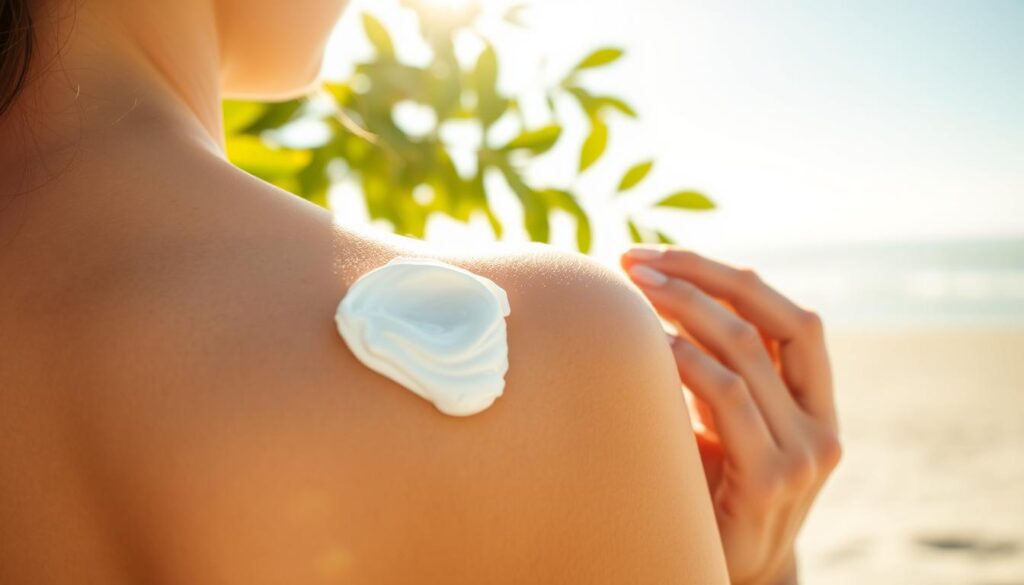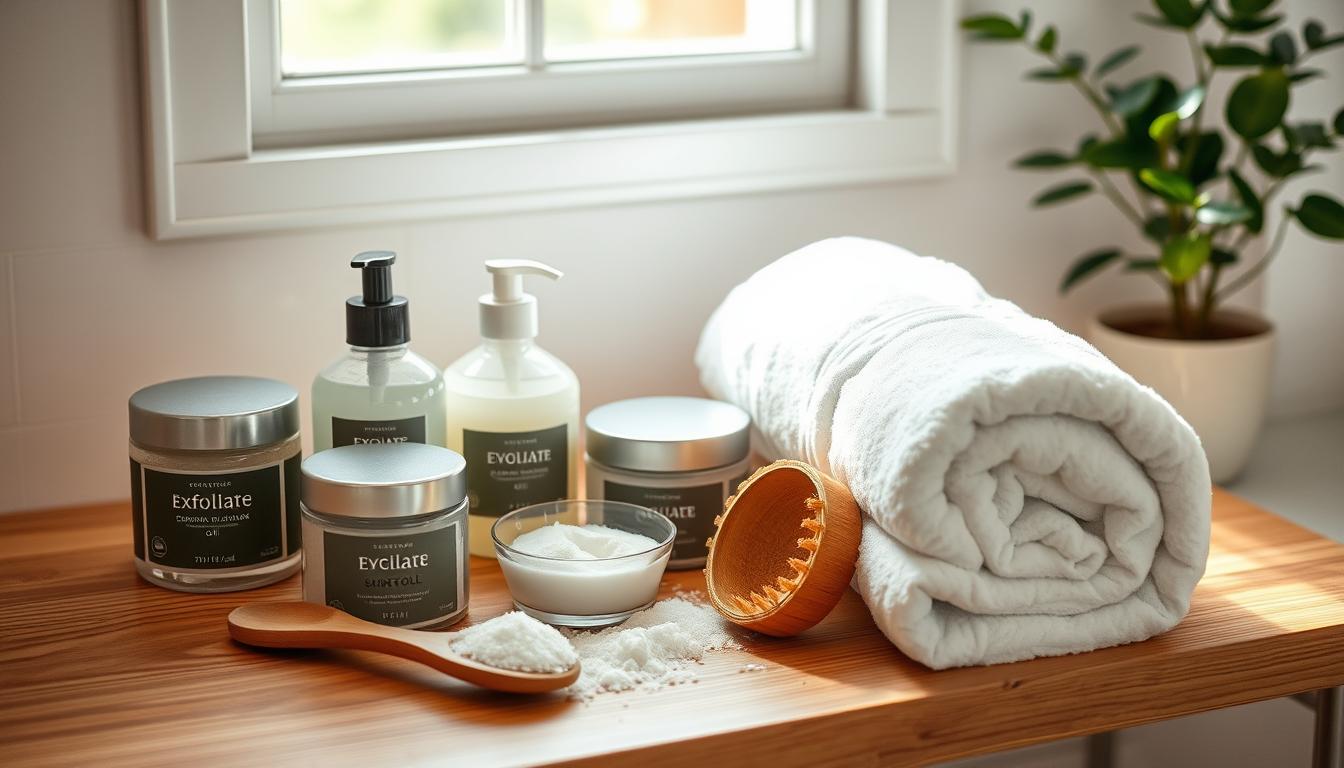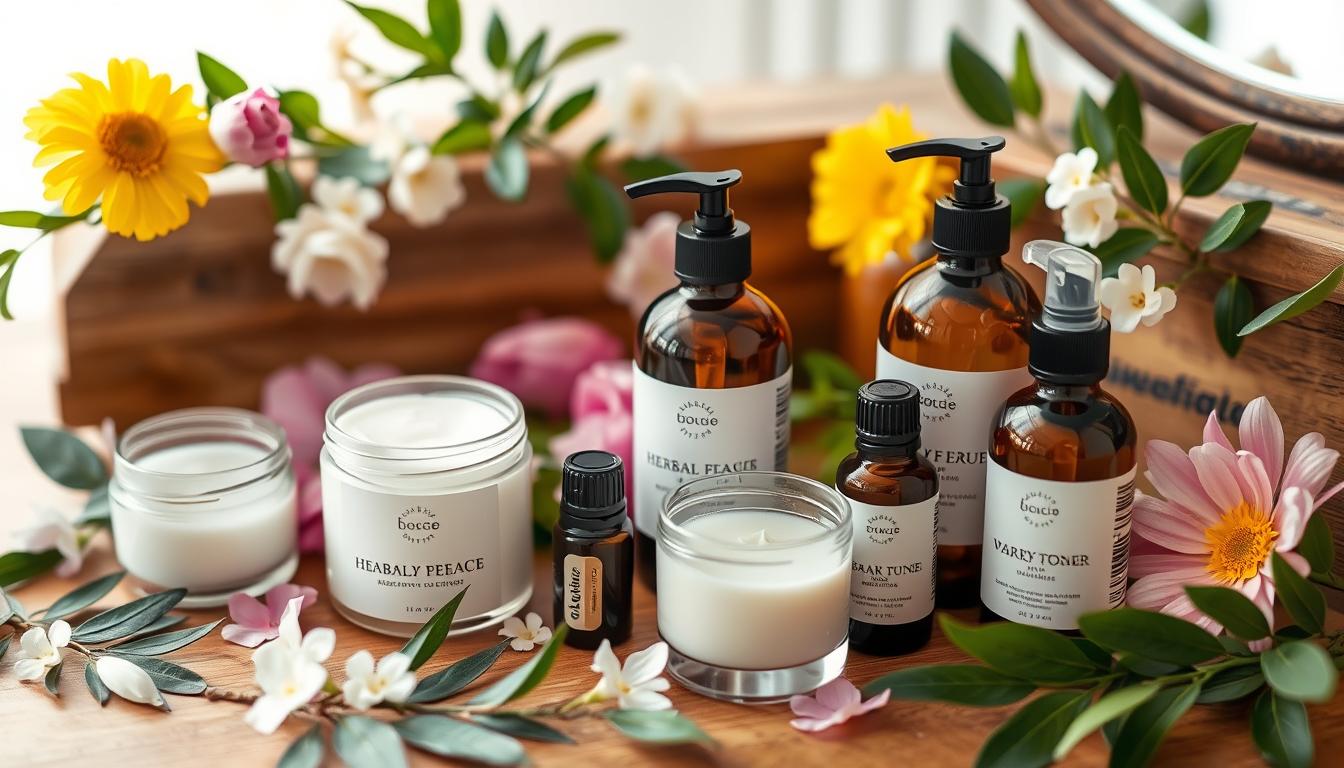Protecting your skin from the sun’s harmful ultraviolet (UV) rays is key to keeping it healthy and vibrant. It also helps lower the risk of skin cancer. This guide will teach you how to shield your skin from the sun’s damaging effects.
Whether you’re at the beach, working outside, or just running errands, knowing about sun protection is crucial. It helps keep your skin safe for the long term. You’ll learn how to pick the right sunscreen and use sun-shielding accessories. This guide will help you protect your skin all year round.
Key Takeaways
- Understand the harmful effects of UV radiation on your skin, including increased risk of premature aging and skin cancer.
- Learn to distinguish between UVA and UVB rays and their distinct impacts on your skin.
- Discover the importance of using broad-spectrum sunscreens with the right SPF to protect against both UVA and UVB exposure.
- Explore techniques for proper sunscreen application to ensure optimal protection.
- Incorporate sun-protective clothing, accessories, and shade strategies to enhance your skin’s defense against harmful UV rays.
Understanding the Importance of Sun Protection
Keeping your skin safe from the sun’s harmful UV rays is key to your health. UV exposure can cause sunburn, premature aging, and increase skin cancer risk. Knowing how important sun protection is, you can protect your skin and stay healthy.
Why UV Rays are Harmful
Ultraviolet (UV) rays from the sun can deeply damage your skin. They can cause sunburns, make your skin age faster, and lead to skin cancer. People with fair or sensitive skin, or a family history of skin cancer, are at higher risk.
The Long-Term Effects of Sun Damage
Long-term sun exposure can cause many skin problems. These include premature wrinkles, age spots, and a higher risk of skin cancer. Skin cancer, like melanoma, is very serious and can be deadly if caught late. It’s vital to have a good sun protection plan for skin cancer awareness and anti-aging skincare.
Recognizing the Signs of Skin Damage
- Irregular mole changes, such as asymmetry, border irregularity, color variations, and diameter growth
- Development of new moles or unusual-looking growths on the skin
- Persistent redness, inflammation, or changes in skin texture
- Excessive dryness, peeling, or irregular pigmentation
Knowing these sunburn prevention signs helps you act fast. If you notice any, seek medical advice right away.

“Protecting your skin from the sun’s harmful UV rays is one of the most important steps you can take for your long-term skin health and wellness.”
| Ultraviolet Ray Type | Effect on Skin |
|---|---|
| UVA | Penetrates deep into the skin, causing premature aging, wrinkles, and increased skin cancer risk. |
| UVB | Primarily affects the outer layer of the skin, leading to sunburns and an elevated risk of skin cancer. |
| UVC | Absorbed by the Earth’s atmosphere, posing minimal direct threat to human skin. |
Types of UV Radiation and How They Affect You
To understand why sun protection is key, we must know about UV radiation. The sun’s ultraviolet (UV) rays come in three types: UVA, UVB, and UVC. Each type affects your skin differently and requires specific UV protection.
UVA vs. UVB: Key Differences
UVA rays are everywhere and go deep into your skin. They cause long-term damage like wrinkles and skin cancer. UVB rays, however, are the main cause of sunburns and most skin cancers.
The Role of UVC in Sun Exposure
UVC rays are the most harmful but are mostly blocked by the atmosphere. Yet, some artificial sources like welding equipment can emit UVC. So, it’s vital to protect your skin in these situations.
Myths About UV Radiation
- Myth: Cloudy days protect us from UV rays. But, up to 80% of UV radiation can pass through clouds. So, UV protection is still needed on cloudy days.
- Myth: Tanning beds are safe. But, they emit UVA rays that can harm your skin and increase cancer risk.
- Myth: Sunscreen is only for summer. UV rays are harmful all year. So, sun protection for skin is important in every season.
Knowing how each UV radiation type affects your skin is crucial. It helps you create a solid skin care plan to shield your skin from the sun.

Choosing the Right Sunscreen for Your Skin
Choosing the right sunscreen is key for sun protection. Sunscreens vary, and knowing the differences helps you pick the best one for your skin.
Broad-Spectrum vs. Regular Sunscreens
Broad-spectrum sunscreens protect against UVA and UVB rays. They offer full sun protection for your skin. Regular sunscreens might only block one type of UV ray, leaving your skin exposed to the other.
SPF Numbers Explained: What Do They Mean?
The SPF number on sunscreen labels shows how well it blocks UV rays. For example, SPF 30 blocks 97% of UVB rays. But remember, no sunscreen can block 100% of UV radiation.
Understanding Ingredients: Physical vs. Chemical Sunscreens
- Physical sunscreens use zinc oxide or titanium dioxide. They reflect and scatter UV rays.
- Chemical sunscreens absorb UV radiation and release it as heat.
Both types protect your skin well. But, if you have sensitive skin, physical sunscreens might be better. They’re less likely to cause irritation.
“Choosing the right sunscreen is the first step in protecting your skin from the harmful effects of UV exposure.”
Proper Application Techniques for Optimal Protection
Applying sunscreen correctly is key for the best sun protection for skin and to avoid sunburn. Here are some tips to make sure you’re using your sun protection right.
How Much Sunscreen Should You Use?
Use about one ounce (a shot glass full) of sunscreen for your whole body. Remember to cover often-missed spots like your lips, ears, eyes, and neck and scalp.
Timing: When to Apply Sunscreen
- Put on sunscreen 15-30 minutes before going outside. This lets it soak into your skin.
- Reapply every 2 hours, or more if you swim or sweat a lot.
- Reapply after drying off with a towel, as sunscreen can wash off.
Common Mistakes to Avoid
- Don’t use too little sunscreen. Most people only use 25-50% of what they should.
- Don’t forget to reapply sunscreen during the day.
- Make sure to put sunscreen on often-missed areas like your lips, ears, and scalp.
- Don’t just rely on sunscreen. Use other sun protection too.
By using these sunscreen application tips, you can keep your skin safe from UV rays. This helps prevent sunburn and long-term sun damage.

Sun Protection Beyond Sunscreen
Sunscreen is important, but it’s not everything. To keep your skin healthy and young, you need a bigger plan. Learn how to protect yourself from the sun in more ways.
Protective Clothing: What to Wear
Wearing sun-safe clothes is a big part of staying safe from the sun. Look for clothes that block UV rays well. Choose light, breathable fabrics like cotton, linen, or bamboo for comfort and UV protection.
- Long-sleeved shirts and pants cover more skin.
- Hats with wide brims protect your face, ears, and neck.
- Sunglasses block UV rays for your eyes and skin.
Accessories for Sun Protection
There are also accessories that help with sun protection. Good sun-blocking accessories can really help your overall protection plan.
- Broad-brimmed hats shade your face, neck, and ears.
- Sunglasses with wraparound frames or large lenses block UV rays.
- Umbrellas or parasols give portable shade outdoors.
Shade and Its Importance
Try to stay in shaded areas to avoid direct sun. This includes natural shade from trees or buildings. Using portable shade like umbrellas also helps. Spending time in the shade lowers your risk of sun damage and keeps your skin healthy and bright.

“Protecting your skin from the sun is not just about sunscreen; it’s about adopting a comprehensive approach that includes protective clothing, accessories, and seeking shade whenever possible.”
Seasonal Considerations for Sun Protection
Sun protection is key all year, but UV rays change with the seasons. It’s vital to adjust your sun care to meet each season’s needs.
Summer: Staying Safe in Peak UV Times
In summer, UV rays are at their strongest. Here’s how to stay protected:
- Use a broad-spectrum sunscreen with SPF 30 or higher often, especially outside.
- Find shade, especially at mid-day when the sun is strongest.
- Wear light, long-sleeved clothes, wide-brimmed hats, and sunglasses to block the sun.
Winter Sun: Protecting Against Reflection
Many think sun protection is just for summer. But winter sun, especially off snow or ice, is dangerous. Here’s how to protect in winter:
- Apply sunscreen on cloudy days too, as UV rays can get through clouds.
- Get good sunglasses to protect your eyes from glare.
- Wear sun-resistant clothes for winter sports like skiing or snowboarding.
Year-Round Skin Wellness
Keep up with sun protection all year for healthy skin. Here’s how:
- Check your skin often for changes or sun damage.
- See a dermatologist if you’re worried about your skin or sun exposure.
- Make sun protection a part of your daily routine, like seeking shade and wearing protective clothes.
By understanding how UV rays change with the seasons and adjusting your sun protection, you can keep your skin healthy and glowing all year.
Special Considerations for Different Skin Types
When it comes to sun protection for skin, one size does not fit all. Different skin types have unique needs. We’ll explore sun protection for sensitive, acne-prone, and melanated skin. This way, you can find the right approach for your skin.
Sun Protection for Sensitive Skin
If you have sensitive skin, choose sunscreens that are gentle. Opt for mineral-based sunscreens with zinc oxide or titanium dioxide. These are less irritating than chemical sunscreens. Also, avoid fragrances, alcohol, and harsh additives that can irritate your skin.
Products for Acne-Prone Skin
Choosing the right sun protection for skin is key for acne-prone skin. Go for non-comedogenic and oil-free sunscreen formulas. Look for products labeled “non-acnegenic” or “won’t clog pores” to avoid breakouts.
Recommendations for Melanated Skin
- Melanated skin tones need careful sun protection for skin to prevent hyperpigmentation and uneven skin tone.
- Choose broad-spectrum sunscreens with an SPF of 30 or higher to protect against UVA and UVB rays.
- Consider adding antioxidant-rich products, like serums or moisturizers, to help defend your skin against sun damage.
Understanding your unique skin type is crucial for effective skin care and sun protection. Tailoring your approach ensures your skin stays healthy, regardless of the weather or season.
Tips for Sun Protection While Outdoors
Enjoying the outdoors is fun, but we must protect our skin from the sun. This is to avoid sunburns and long-term damage from UV rays. Whether hiking, swimming, or just relaxing in the park, there are key tips for sunburn prevention.
Activities That Require Extra Protection
Some outdoor activities increase sun exposure risks. These include:
- Water-based activities like swimming, boating, and surfing, where reflective surfaces can amplify UV rays
- High-altitude pursuits such as skiing or mountaineering, where the thinner atmosphere offers less UV protection
- Prolonged exposure to direct sunlight, like spending a day at the beach or on a hiking trail
Reapplying Sunscreen: Best Practices
Proper sun protection for skin doesn’t stop with the first sunscreen application. It’s vital to reapply sunscreen to keep UV protection up all day. Experts say to reapply every 2 hours, or more if swimming or sweating.
Staying Hydrated and Healthy
Staying hydrated is key for your health and sunburn prevention. Dehydration makes your skin more vulnerable to sun damage. Drink lots of water before, during, and after being outside.
Eating a balanced diet with antioxidants also helps protect your skin. Foods like leafy greens, berries, and fatty fish support your skin’s defenses against UV rays. Adding these to your diet can enhance your sun protection for skin.
Evaluating Your Sun Protection Routine
Keeping a good sun protection routine is key for your skin’s health. It’s important to check and update your routine often. This way, you can keep your skin safe from UV radiation harm.
Signs You Need to Change Your Approach
Changes in your skin, like new moles or discoloration, mean it’s time to review your sun protection. Also, if you get sunburned often or see signs of aging early, like fine lines, it’s a sign to change your habits.
Regular Skin Checks: Why They Matter
Doing regular skin checks is crucial for your skin’s health. Get to know what your moles and freckles look like. Look for any changes. Catching skin cancer early can greatly improve treatment results, so don’t delay in getting a professional skin check.
Consulting Professionals: When to Seek Help
If you’re worried about your skin or sun protection, talk to a dermatologist or skin care expert. They can give you tailored advice, suggest better sun protection products, and do detailed skin checks. Your skin’s health is worth it, so don’t hesitate to get expert help when needed.



